| Royal Mt.
Trekking (P) Ltd. P.O. Box: 10798, Durbar Marg, Kathmandu, Nepal Tel: 241452 / 258236 Fax: 977-1-245318 E-mail: Royalmt@mos.com.np |
| Royal Mt.
Trekking (P) Ltd. P.O. Box: 10798, Durbar Marg, Kathmandu, Nepal Tel: 241452 / 258236 Fax: 977-1-245318 E-mail: Royalmt@mos.com.np |
Trekking in Nepal
A trek is walking at one's own pace through well established village trails whereby one will enjoy a close contact with people in remote mountain villages whose lifestyle has not been changed for generation. Perhaps the most enjoyable part of a trek is the clean mountain air and magnificent views of the mighty Himalayan peaks. One will feel at pleasure with nature and with oneself.
Even on an easy trek one will require to walk for about 5 to 6 hours daily on an uneven terrain and therefore one must use to regular exercise.
| 2
pairs of pants 2-3 T-shirts Long sleeve shirts Wool sweater 2-3 Pairs of underwear 2-3 Pairs of socks Woolen socks Sun hat Woolen hat Jacket Rain poncho (summer) Down Jacket (winter) Trekking boots Camping shoes (sandals, slippers, etc.) Gloves |
Thermal
wear (winter) Swimming suit Sunglasses Back pack Flashlight (extra batteries) Sunscreen, lip balm, etc. Down sleeping bag First aid kit (Hydrogen Peroxide, iodine, Band-Aids, tape, Aspirin, etc.) Walk man (extra batteries), books, games (cards, etc.) Toiletries (toothbrush, toothpaste, deodorant, soap, toilet paper, etc.) Pocket knife, compass etc. Camera & film Water bottle, purifier (iodine tablets, etc.) Walking sticks Extra money |
The day begins at 6 AM with tea or coffee in bed and a large bowl of warm water for a wash. Then breakfast consisting of porridge, eggs bread/pancake, tea/coffee is served. while having breakfast the guide crew will bring down the tents. Hence, pack up the duffel bags and rucksacks before sitting for breakfast. By 8 AM one will be on his way to take advantage of the cool morning to accomplish most of the day's hike. Lunch is usually served by noon which normally consists of light hot meal. The afternoon's walk is usually short lasting 2-3 hours. Tents are put up much before sunset and soon after dinner is served which is more elaborate consisting of hot soup, a variation of cuisine of Nepali, Chinese or continental food rounded off with a dessert and a hot cup of tea or coffee. Bed
INCLUSIVES ON THE COST (CAMPING TREK):
Trekking permit, Transportation (land) to and from. Three meals a day on the trekking (cooking utensils), All the necessary equipment’s such as tents (twin sharing), down sleeping bag, down jacket, mattresses, water bottles, Rain poncho, Ice axe, and a guide, cook, kitchen boy and porters etc.
INCLUSIVES ON THE TARIFF (TEA HOUSE TREK):
Trekking permit, Transport by land to and from, Accommodation (In the lodges along the way), Food 3 meals (providing from the menu), A guide and necessary porters, most essential equipments, Sleeping bag, Jacket, Rain poncho, Water bottle, etc.
EXCLUSIVE ON THE COST OF BOTH TYPE OF TREKS:
National Park fee, Emergency evacuation, personal expenses (drinks from local market, day pack, gloves, medical kits, etc.), airfare to any destination on the trekking, other royalties for the Govt. specified region and Insurance, etc.
Tour Code: Royal / KSNT 1-5
KAKANI - SHIVAPURI - NAGARKOT TREK (5 DAYS)
This trek around the beautiful valley is the ideal trek for those having very limited time and have a very short holiday period. It offers a rich insight into the lives, history, culture and religion together with the lifestyles of different people living nearby the Kathmandu Valley.
Day 01. Kathmandu - Kakani - Aaledanda: Drive to Kakani 29 km. north west from .Kathmandu; a magnificent views ............ .of the valleys and panorama of the Himalaya can be observed from here. Then walk to Aaledanda along the ..............ridge in the National Park area.
Day 02. Aaledanda - Shivapuri: A decent walk from Aaledanda to Shivapuri forest ..viewing a wholesome Himalayan ............ .range of Annapurna, Manaslu, Ganesh Himal, Langtang and Jungle Himal. Camp at. Shivapuri.
Day 03. Shivapuri - Dhap: Walk along the ridge between the Shivapuri watershed ..forest and the panoramic attraction ............ .of the Himalaya and camp at Dhap.
Day 04. Dhap - Nagarkot: Walk between the village and forest, then arrive at ..Nagarkot, to have an outstanding view ............ .of Gaurishankar and Mt. Everest.
Day 05. Nagarkot
- Banepa - Kathmandu: An easy walk down hill to Banepa (
a .historical city). It was a small
............
.kingdom during the
decade of 1880. Then .drive to Kathmandu.
Tour Code: Royal / TRT 2-6
THE ROYAL TREK (6 DAYS)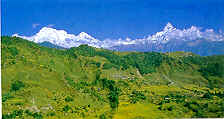
As you walk along the peaceful ranges with terraced hills all around, colorful fauna painting the landscape, eagles soaring high above, and the majestic Annapurna Himalayas towering all around, you will feel higher than royalty, discovering the charisma of nature.' The name of this trek "The Royal Trek" was perceived after the Prince Charles of Great Britain trekked here in 80s.
Day 01. Kathmandu-Begnas Tal (lake): Drive to Begnas Tal and walk to Sundar Danda for one hour which is between ..............two beautiful lakes and camp overnight. Also visible from hrer Annapurna and Dhulagiri range.
Day 02. Sundar Danda- Chisapani: Start a walk of 3 hours to Bhirchwok and continue walking for some hours till ..............Chisapani which is the highest point of this trek and provides a beautiful scenery around.
Day 03. Chisapani- Lippyani: Trek for 2 hours to Ramkot then to Syaklung after two hours walk and stay overnight..
Day 04. Lippyani-Kalikasthan: Start trekking and reach Kalikasthan after 5/6 hours to halt the night from where one ..............can.see a beautiful view of mountain range, Begnas Lake and the entire Pokhara Valley.
Day 05. Kalikasthan to Pokhara: Descend to Phedi and drive for one hour to Pokhara Valley synonymously called ..............Switzerland of Nepal.
Day 06. Pokhara- Kathmandu: Drive or fly back (200 km)
Tour Code : Royal / PT 3 - 6
PANCHASE TREK (6 DAYS)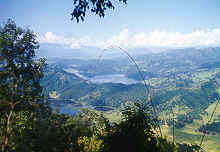
Panchase Trekking being one of the non-tourist areas lasts for about 6 days and offer you varieties of spectaculars such as Annapurna and Dhaulagiri mountain views, ethnic villages, cultures, and the lifestyles of those especially from the western part of Nepal. Furthermore, it’s always done with a guided group and tented camps.
Day 01 Kathmandu to Pokhara ( 200 kms ): Drive or fly to Pokhara from .............Kathmandu and stay at a hotel.
Day 02. Pokhara to Bhumdi (1652 m.): Drive to Thadokhola via David Fall and trek towards Bhumdi. Mt. Annapurna ..............I, .II, III, and IV, Manaslu, Langtang, Ganesh Himal and Fish tail can be seen from here; overnight at Bhumdi.
Day 03. Bhumdi to Bhanjyang (2132 m.): Ascend towards Bhanjyang also enjoying the fascinating views of Pokhara ..............valley and Phewa Lake. Overnight at Bhanjyang.
Day 04. Bhanjyang to Naudanda (1445 m.): Ascend towards Panchase Ridge (2432 m.) (the highest point of this ..............trekking), Pokhara valley, Kusma valley, Modi River, entire Annapurna Range, Mt. Dhaulagiri and other ..............mountains can be closely observed. Then walk towards Naudada via Bhadure for the overnight stay.
Day 05. Naudanda to Pokhara (901 m.): Start trekking and reach Sarangkot, descend about 2_ hrs. and drive to ..............Pokhara and have a rest of the day.
Day 06. Pokhara to Kathmandu: Drive or fly back to Kathmandu from Pokhara.
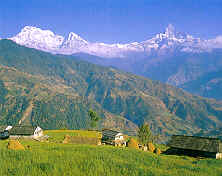
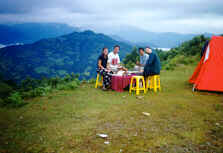 Tour
Code: Royal / ST 4-8
Tour
Code: Royal / ST 4-8
SIKLISH TREK ( 8 DAYS )
This is also one of the non-tourist areas providing varieties of scenic beauties and ethnic villages comprising of different tribes. And it is always done with a guided group.
Day 01 Kathmandu to Pokhara ( 200 kms ): Drive or fly to Pokhara from Kathmandu and camp at Lakeside.
Day 02. Pokhara to Kalikasthan: Drive to Bijayapur and trek through villages of different tribes to Kalikasthan, ............. camping .at the top of the mountain which offers you panoramic views of the Himalaya.
Day 03. Kalikasthan to Lamachour: Walk down hill to the river valley, with views of water falls and then climb towards ..............Lamachour and camp there.
Day 04. Lamachour to Siklish: Climb to Siklish through rhododendron forest and the greatest Gurung Village (known .............as .Gurkhas), the best point to see the panorama of Himalaya and close views of Lamjung Himal, Annapurna II .............and Manaslu.
Day 05 & 6 Siklish to Ghale Gaon: Descend through the forest and a smaller village to the interesting Ghale village. .............You .may be interested to stay one more day here, for the panoramic attraction of the fishtail.
Day 07. Ghale Gaon to Pokhara: The trail descends to Pokhara through different villages of different tribes (Brahman, ..............Chhetri, Gurung, Thakali). Arrive at Pokhara and camp at the lake side.
Day 08. Pokhar to Kathmandu: After breakfast fly or drive to Kathmandu.
Tour Code: Royal / TGVTT 5 - 10
GHOREPANI and TATOPANI TREK ( 10 DAYS)
This is one of the interesting and shortest treks from where you will have closer views of some of the highest peaks of Nepal; Machhapuchhre, Annapurna and Dhaulagiri. The other interesting thing in this trek is, you will be passing through Kaligandaki which is one of the deepest gorges in the world.
Day 01. Kathmandu to Pokhara: Fly or drive to Pokhara (200 km.) Stay in Pokhara.
Day 02. Pokhara to Pothana: 45- minute drive to Suikhet Phedi, commence the trek and Lunch at Dhampus and over ..............night at Pothana.
Day 03. Pothana to Ghandrung: Lunch after 3 hrs. walk at Landrung, stay at Ghandrung
Day 04. Ghandrung to Ghorepani: Lunch at Tadapani after 3 hrs. walk and camp ate Ghorepani, visible Annapurna and ..............Dhaulagiri from here.
Day 05. Rest at Ghorepani and Excursion to the Poon Hill( the highest hill in the west in the whole trek ), bird- eye ..............view of Mustang and Pokhara valleys, also provides clear view of 30 snow-capped peaks including the ..............Annapurna range and Dhaulagiri.
Day 06. Ghorepani to Tatopani (Hot Spring): At least 5 hrs. walk down-hill to Tatopani also Kaligandaki valley. ..............Lunch at Ghara. .
Day 07. Tatopani to Beni: Walk through the banks of Kaligandaki for 3 hrs. stop for lunch at Garamdi Bridge. ..............Overnight at Beni.
Day 08. Beni to Pokhara: An interesting journey through terrace fields of corn and paddy, and meadows. Rest in ..............Pokhara.
Day 09. Pokhara to Kathmandu: Fly or drive to Pokhara (200 km.) .
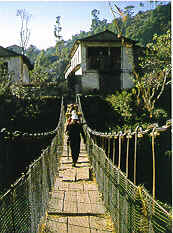
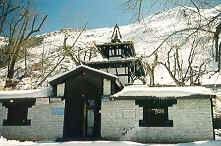 Tour
Code: Royal / JMT 6 - 13
Tour
Code: Royal / JMT 6 - 13
JOMSOM -MUKTINATH TREK (13 DAYS)
This trek is bound to provide visitors a wonderful landscape with surrounding mountain and the several other charisma of natural beauties. Muktinath, being one of the most important pilgrimages of Hindus and Buddhists both has been attracting several visitors both foreign and domestic for a quite a long time. This visit hopefully will remain in your long lasting memories of travel experience.
Day 01. Kathmandu to Pokhara : Kathmandu to Pokhara ( 200 kms), drive or flight, stay ..............in Pokhara
Day 02. Pokhara to Kagbeni (2858 m.): Morning flight to Jomsom, walk to Ekley Bhatti Village after 3 hrs through the ..............bank of Kaligandaki and have lunch; trek one more hour to Kagbeni lying between two rivers, Kaligandaki ..............(flows .from Muktinath) and Nilgiri (flows from Mt. Nilgiri).
Day 03. Kagbeni to Muktinath (3817 m.): ¾ hours walk, an important pilgrimage for both Hindus and Buddhists with a ..............Gompa and a pagoda style Pagoda dedicated to Lord Bishnu.
Day 04. Muktinath to Jomsom (2709 m.): A walk down hill with a dramatic landscape upto Jomsom.
Day 05. Jomsom to Tukuche (2591 m.): (5/6 hrs. walk), a valley dominated by Thakalis, Gurungs andd Magars ..............(tribes), .lunch at Marfa on the way.
Day 06. Tukluch to Ghasa (1970 m.): 5/6 hrs walk, a dramatic change in the surrounding with green vegetation and very ..............beautiful view of Dhaulagiri and Annapurna region. Overnight at Ghasa.
Day 07. Ghasa to Tatopani (1189 m.): 5/6 hours walk, gradual descend to Tatopani through valleys, fields and the ..............beautiful Rupse Chhahara (water falls) and then the time to have lunch at Dana village which is the deepest gorge ..............in the world. Rest and overnight at Tatopani.
Day 08. Tatopani to Ghorepani (2793 m.): (6/7 hrs. walk), A challenging ascent upto Ghorepani. Lunch at Sikha ..............village,.and overnight at Ghorepani from where one can observe the best sun set view over the profile of Mt. ..............Dhaulagiri.and Annapurna.
Day 09. Rest at Ghorepani and Excursion to the Poon Hill( the highest hill in the west in the whole trek ), bird- eye ..............view of .Mustang and Pokhara valleys, also provides clear view of 30 snow-capped peaks including the ..............Annapurna range and Dhaulagiri.
Day 10. Ghorepani to Ghandrung (1951 m.): 6/7 hours, with ups and downs towards Tadapani for lunch and camp at ..............Ghandrung which is the biggest Gurung settlement with a closer view of Annapurna, Machhapuchhre and ..............Hiunchuli.
Day 11. Ghandrung to Pothana (1980m): 5/6 hours, walk downwards to Modi river and ascend to Landrung, a ..............beautiful Gurlung village and lunch at Tolkha and yet another easy ascent up to Deurali. Overnight at Pothana.
Day 12. Pothana to Pokhara: ¾ hours easy way down via Dhampus village to Phedi then d one hour drive to Pokhara
Day 13. Pokhara to Kathmandu: Fly or drive back to Kathmandu ( 200 kms )
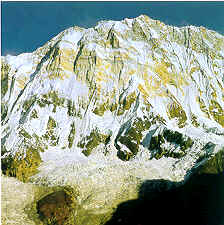
Tour Code: Royal / AST 7 - 13
ANNAPURNA SANCTUARY TREK (13 DAYS)
This trekking traverses varieties of terrain from lowland villages to magnificent Glaciers and outstandingly beautiful mountain views. It also offers a good opportunity to indulge in the surrounding Himalayan Peaks without being obsessed with the problems of high altitude.
Day 01. Kathmandu to Pokhara: Fly or drive west to Pokhara (200 km.) and stay overnight.
Day 02. Pokhara to Tikhedhunga (1,577 m.): Two-hour drive to Birethanti, and start trekking following Bhurungi ............. Khola and reach Tikhedhunga.
Day 03. Tikhedhunga to Ghorepani (2,855 m.): Ascend to Ulleri Village through a plesant Rhododendron forest and .............arrive at the top of Ghorepani pass and camp overnight.
Day 04. Ghorepani to Tadapani(2,680 m.): Early wake up and walk up to Poon Hill for one hour to observe the .............sun-rise and a magnificent mountain view and walk back to Ghorepani for breakfast and start trekking to .............Tadapani.
Day 05. Tadapani to Chhomrong (1,951 m.): An easy way down to Kimrung Khola for lunch, ascend again to .............Chhomorong village which lies at the base of Hiunchuli at the elevation of 6,441m. which also offers a close view .............of Annapurna and Macchhapucchhre.
Day 06. Chhomrong to Himalaya Hotel (2,873 m.): Forward to Kuldi Ghar for about 3 hrs. and down to the bank of .............Modi river viewing thickets of bamboo at the bottom of the gorge. Passing by the pasture of Tomo and Panchen .............Barah climb up to Himalayan Hotel and camp overnight.
Day 07. Himalayan Hotel to Annapurna Base Camp (4130 m.): Keeping up on the west bank of Modi follow a more .............open valley at the side of Machhapuchhre Base Camp leaving you the choice- either to stay or continue to the .............Annapurna Base Camp.
Day 08. Annapurna Base Camp Visit: This is usually a rest day. However, the glacial moraine, charismatic mountain .............views can be indulged in. Excursion of one of the biggest glaciers ( Annapurna Glacier ) is just another charm.
Day 09. Annapurna Base Camp to Bamboo: Descend and follow the same way to a pleasant camp spot at Bamboo.
Day 10. Bamboo to Himalpani (Hot Spring): Walk up to Chhomrong and further way down to Himalpani to have a .............feel of hot spring water and camp overnight at the bank of Modi river.
Day 11. Himalpani to Pothana (1980m): Walk downwards to Modi river and ascend to Landrung, a beautiful Gurlung ..............village and lunch at Tolkha and yet another easy ascent up to Deurali. Overnight at Pothana.
Day 12. Pothana to Pokhara: ¾ hours easy way down via Dhampus village to Phedi then d one hour drive to Pokhara
Day 13. Pokhara to Kathmandu: Fly or drive back to Kathmandu ( 200 kms )
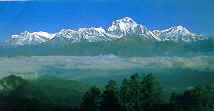 Tour Code: Royal / GPT 8 - 8
Tour Code: Royal / GPT 8 - 8
GHOREPANI "POON HILL" TREK (8 DAYS)
Day 01. Kathmandu to Pokhara: Fly or drive west to Pokhara (200 km.) and stay overnight.
Day 02. Pokhara to Tikhedhunga (1,577 m.): Two-hour drive to Birethanti, and start trekking following Bhurungi ..............Khola .and reach Tikhedhunga.
Day 03. Tikhedhunga to Ghorepani (2,855 m.): Ascend to Ulleri Village through a plesant Rhododendron forest and ..............arrive at the top of Ghorepani pass and camp overnight.
Day 04. Rest day at Ghorepani: Early wake up and trek to Pun Hill (3153 m.) to see the sunrise view over the snowy ..............mountain. Then come back to Ghorepani for a rest of the day.
Day 05. Ghorepani to Ghandrung (1922 m.): The trek gradually goes up through the thick forest to Banthanti where the ..............lunch will be served. Then reach Ghandrung after two or three hours walk. Mt. Annapurna South, Gangapurna, ..............Machhapuchhere (Fish Tail) and other snowy mountains can be seen beautifully from here.
Day 06. Ghandrung to Pothana (1980m): Walk downwards to Modi river and ascend to Landrung, a beautiful Gurlung ..............village and lunch at Tolkha and yet another easy ascent up to Deurali. Overnight at Pothana.
Day 07. Pothana to Pokhara: ¾ hours easy way down via Dhampus village to Phedi then d one hour drive to Pokhara
Day 08. Pokhara to Kathmandu: Fly or drive back to Kathmandu ( 200 kms )
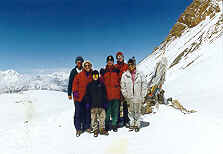
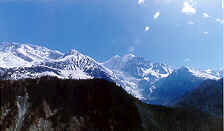
Tour Code: Royal / ACT 9 - 21
ANNAPURNA CIRCUIT TREK ( 21 DAYS)
This is one of the classic and most rewarding treks in Nepal. The Southern slopes of Manaslu and, Annapurna ranges are heavily settled and farmed except the higher regions which support thick forests of Rhododendron and fir. Most of the tribes inhabiting this area are Gurungs, Magars, Chehettris and Newars. Thakali and Mustang tribes control the busy trading and pilgrimage trail along the Kali Gandaki. One of the most striking significance of this trek is that we have a spectacular view of most mountains range every day.
Day 01. Kathmandu to Beshi Sahar: Drive to Dumre by tourist Bus following wild hairpin bends, and drive by local ..............vehicles about 3 hrs. approximately to reach Besi Sahar and rest.
Day 02. Beshi Sahar to Nadi (1011m): Walk for about 6 hours towards Nadi through narrow tracks, suspension ..............bridges ..and a deep river gorge. Overnight at Nadi.
Day 03. Nadi to Jagat (1314m): Walk for about 7 hours towards Jagat through the valley crossing several suspension ..............bridges and passing several beautiful waterfalls land view the tower of Mt. Lamjung (22,291 Ft.), Manaslu ..............(26,760 Ft.) and Peak 29 (24,652 Ft.). Overnight at Jagat.
Day 04. Jagat to Dharapani (1943m.): Walking distance of about 7 hours from Jagat to Dharapani, entering Manang ..............district from Taal and crossing a large bridge to Dharapani to stay overnight.
Day 05. Dharapani to Chame (2713m): The distance is covered within 6 hours. The trail now leads to the west in ..............Manaslu .forming a splendid backdrop of Annapurna II appearing occasionally to the south. As we continue, ..............Annapurana range offers a splendid view. Overnight at Chame.
Day 07. Chame to Pissang (3185m.): Keeping by the side of river all day for about 7 hours and passing through narrow ..............and steep gorge reach Passing from where Manang Valley (a wide U - shaped valley) hanging between two giant ..............snow peaks. Overnight at Pissang.
Day 08. Pissang to Manang (3351m.): After a 7-hour walk through trails and broad forested valley floor a small stool ..............airstrip and a village of about 200 houses and Barge monastery which is the largest in the entire district and reach ..............Manang.
Day 09. Rest in Manang for acclimatization: A necessary day to rest and acclimatize and explore Manan,. the village ..............of about 500 flat roofed houses. Annapurna II, Annapurna III (24,787 Ft.), Gangapurna (24,457 Ft.) and Chulu ..............East (19,880 Ft.) to the north can be well viewed.
Day 10. Manang to Thorong Phedi (4335m.): We branch away from the Marsyandi Khola steadily climbing into quiet ..............distinct alpine areas. Crossing the Jarsang Khola we climb to a small grassy valley and camp. Approximately 5 ..............hrs walk.
Day 11. Thorong Phedi to Muktinath (3798m.): Crossing the pass early in the morning slowly reach the top of Thorang ..............Pass (5417m.) and enjoy some absolutely stunning high Himalaya scenery and over to the Kaligandaki valley ..............through the entire Annapurna range , Mukut and Mustang Himal to the west. Walking distance is about 8 hours.
Day 12. Muktinath to Jomsom (2709 m.): A walk down hill with a dramatic landscape upto Jomsom.
Day 13. Jomsom to Tukuche (2591 m.): (5/6 hrs. walk), a valley dominated by Thakalis, Gurungs andd Magars .............(tribes), lunch at Marfa on the way.
Day 14. Tukluch to Ghasa (1970 m.): 5/6 hrs walk, a dramatic change in the surrounding with green vegetation and very ..............beautiful view of Dhaulagiri and Annapurna region. Overnight at Ghasa.
Day 15. Ghasa to Tatopani (1189 m.): 5/6 hours walk, gradual descend to Tatopani through valleys, fields and the ..............beautiful Rupse Chhahara (water falls) and then the time to have lunch at Dana village which is the deepest gorge ..............in the world. Rest and overnight at Tatopani.
Day 16. Tatopani to Ghorepani (2793 m.): (6/7 hrs. walk), A challenging ascent upto Ghorepani. Lunch at Sikha .............village, and overnight at Ghorepani from where one can observe the best sun set view over the profile of Mt. .............Dhaulagiri .and Annapurna.
Day 17. Rest at Ghorepani and Excursion to the Poon Hill( the highest hill in the west in the whole trek ), bird- eye ..............view of Mustang and Pokhara valleys, also provides clear view of 30 snow-capped peaks including the ..............Annapurna range and Dhaulagiri.
Day 18. Ghorepani to Ghandrung (1951 m.): 6/7 hours, with ups and downs towards Tadapani for lunch and camp at ..............Ghandrung which is the biggest Gurung settlement with a closer view of Annapurna, Machhapuchhre and ..............Hiunchuli.
Day 19. Ghandrung to Pothana (1980m): 5/6 hours, walk downwards to Modi river and ascend to Landrung, a ..............beautiful Gurlung village and lunch at Tolkha and yet another easy ascent up to Deurali. Overnight at Pothana.
Day 20. Pothana to Pokhara: ¾ hours easy way down via Dhampus village to Phedi then d one hour drive to Pokhara
Day 21. Pokhara to Kathmandu: Fly or drive back to Kathmandu ( 200 kms )
............................................Tour Code: Royal / EBCT 10
- 20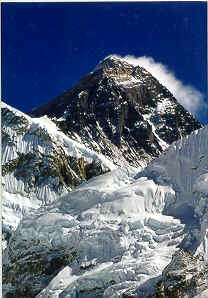
EVEREST BASE CAMP TREK (20 DAYS)
Mt. Everest, the highest peak of the world is certainly the most fascinating trek that one could ever think of. The Everest ( 8848m. ) is not only a trekking destination but also a journey through which one can witness a diverse community, cultures, religions and most of all, the world famous Sherpa cult, the most widely known climbers of the world.
Its uniqueness is that it starts from low land (Jiri). However, there are also some other alternatives such as flying to Lukla and start trekking.
Day 01. Kathmandu to Jiri (1,905 m.): Drive from Kathmandu to Jiri 187 k. m. ( 10 hrs. ) by bus; through beautiful ..............mountains, terraced fields and the Crystalline beauty of Sun Koshi (River of Gold).
Day 02. Jiri to Deurali (3,000 m.): Climbing towards Mali about 1 hr. and descend to Shivalaya about the same ..............duration .then diagonally up to Deurali (3,000 m.) about 3 hrs.
Day 03. Deurali to Sete (2,575 m.): Walking duration 6 hours. Straight down to Thado Khola and walk through river ..............valley to Kinja then, up to sete.
Day 04. Sete to Junbesi (2,675 m.): The trail goes upwards to Lamjura Pass (3,500 m.) the first view point of Everest ..............and .descend to Junbesi for about 3 hrs from where one can see good views of Mt. Gaurishankar, Numbur ..............Himal and .Dudh Kunda.
Day 05. Junbesi to Noonthala (2,194 m.): Walk up a slanting trail about 2 hrs to Solung then descend to Ringmo Khola ..............& up to Taksindo Pass afterwards descend to Noonthala.
Day 06. Noonthala to Khari Khola (2,072 m.): Walk about 5 hours. The descent continues to Dudh Koshi (River of ..............Milk) and ascend to Khari Khola walking through several Sherpa villages, terraced fields and forests.
Day 07. Khari Khola to Phuiyan (2,835 m.): Ascend towards Phuiyan through a Sherpa village and a forest inhabited ..............by monkeys. 5 hours of walking.
Day 08. Phuiyan to Phakding (2,652 m.): The trail climbs for about an hour to a ridge at 2,800 meters then up to ..............another ridge then climb for another 15 minutes to a junction and climb again towards Phakding.
Day 09. Phakding to Namche Bazar (3,446 m.): With a slight climb to Jorsalle, pass a waterfall along this part of the ..............trail villages enjoying magnificent forest of Rhododendron, Mangoliya, and Giant Firs then walk up to Namche ..............Bazar.
Day 10. Rest at Namche Bazar: Rest day at Namche Bazar for acclimatization
Day 11. Namche Bazar to Tengboche (3,867 m.): An easy walk to Phunki for three hours and on the way, one can see ..............blue sheep, musk deer and different Himalayan animals and birds. Ascend for another 3 hours to Tengboche. ..............Tengboche offers a beautiful glance of Mt. Everest, Nuptse, Lhotse, Cholatse, Thamserku and Amadablam.
Day 12. Tengboche to Pheriche (4,252 m.): A short step to Devuche through a forest of Birches, Conifers and ..............Rhododendrons then, ascend to Pangboche through the forest and carved Mani stones at 3,860 meters. Then the ..............route enters Pheriche.
Day 13. Rest at Pheriche: Acclimatization day.
Day 14. Pheriche to Lobuche (4,930 m.): The trail ascends the broad gently sloping valley and climbs steeply into the ..............terminal moraine of Khumbu. Glaciers then crosses the bridge and climbs higher on the moraine to a row of ..............stone's monuments in the memory of six Sherpas who died in an avalanche at Lobuche.
Day 15. Lobuche to Kalapatthar (5,545 m.), Gorakshep (5,151 m.): This trail provides a wonderful view of Pumori. ..............This section of the trek provides good views of the Everest Group from Gorakshep and Kalapatthar. Especially ..............Kalapattar offers a closest view of Mt. Everest and as well as hundreds of other beautiful peaks including that of ..............Tibet.
Day 16. Gorakshep to Everest Base Camp to Lobuche: Everest Base (5,245m) Camp is the main camp for the ..............Mountaineers as they have all the beautiful snowy mountains around and they really make it a life time memory in ..............their travel hitory.
Day 17. Lobuche to Tengboche: The easy way back
Day 18. Tengboche to Namche Bazar:
Day 19. Namche Bazar to Lukla:
Day 20. Lukla to Kathmandu: Fly back ( 45 minutes )
Tour Code: Royal / EBCT 11 - 13
EVEREST BASE CAMP TREK (13 DAYS)
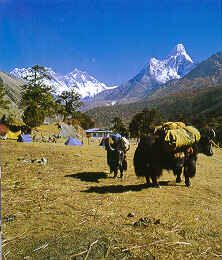
Mt. Everest, the highest peak of the world is certainly the most fascinating trek that one could ever think of. The Everest ( 8848m. ) is not only a trekking destination but also a journey through which one can witness a diverse community, cultures, religions and most of all, the world famous Sherpa cult, the most widely known climbers of the world.
Day 01. Kathamandu to Phakding (2,652m): Fly ( 45 mins.) from Kathmandu to Lukla ............. and walk towards Phakding via .Chaurikharka, a Sherpa settlement who will always ............. greet with smiles.
Day 02. Phakding to Namche Bazar (3,446 m.): With a slight climb to Jorsalle, pass a .waterfall along this part of the ............. .trail villages enjoying magnificent forest of .Rhododendron, Mangoliya, and Giant Firs then walk up to Namche ............. Bazar.
Day 03. Rest at Namche Bazar: Rest day at Namche Bazar for acclimatization
Day 04. Namche Bazar to Tengboche (3,867 m.): An easy walk to Phunki for three hours and on the way, one can see ..............blue sheep, musk deer and different Himalayan animals and birds. Ascend for another 3 hours to Tengboche. ..............Tengboche offers a beautiful glance of Mt. Everest, Nuptse, Lhotse, Cholatse, Thamserku and Amadablam.
Day 05. Tengboche to Pheriche (4,252 m.): A short step to Devuche through a forest of Birches, Conifers and ..............Rhododendrons then, ascend to Pangboche through the forest and carved Mani stones at 3,860 meters. Then the ..............route enters Pheriche.
Day 06. Rest at Pheriche: Acclimatization day.
Day 07. Pheriche to Lobuche (4,930 m.): The trail ascends the broad gently sloping valley and climbs steeply into the ..............terminal moraine of Khumbu. Glaciers then crosses the bridge and climbs higher on the moraine to a row of ..............stone's monuments in the memory of six Sherpas who died in an avalanche at Lobuche.
Day 08. Lobuche to Kalapatthar (5,545 m.), Gorakshep (5,151 m.): This trail provides a wonderful view of Pumori. ..............This section of the trek provides good views of the Everest Group from Gorakshep and Kalapatthar. Especially ..............Kalapattar offers a closest view of Mt. Everest and as well as hundreds of other beautiful peaks including that of ..............Tibet.
Day 09. Gorakshep to Everest Base Camp to Lobuche: Everest Base (5,245m) Camp is the main camp for the ..............Mountaineers as they have all the beautiful snowy mountains around and they really make it a life time memory in ..............their travel hitory.
Day 10. Lobuche to Tengboche: The easy way back
Day 11. Tengboche to Namche Bazar:
Day 12. Namche Bazar to Lukla:
Day 13. Lukla to Kathmandu: Fly back ( 45 minutes )
Tour Code: Royal / EVT 12 - 9
EVEREST VIEW TREK (9 DAYS)
This trek is suitable to those who have limited time but have a strong desire to see the Mt. Everest closely. This trek starts from Lukla and ends at Lukla. Going through Sherpa villages and beautiful monasteries being around the world’s beautiful snowcapped mountains is just another charm of this trek.
Day 01. Kathmandu to Lukla (2,827 m.): Fly 45 minutes then walk to Phakding (2,652 ) about 3 hrs.: The trail ..............descends steadily through the bank of Dudh Koshi river, Sherpa villages and mani stones and reaches to ..............Phakding for camp.
Day 02. Phakding to Namche Bazar (3,446 m.): With a slight climb to Jorsalle, pass a waterfall along this part of the ..............trail villages enjoying magnificent forest of Rhododendron, Mangoliya, and Giant Firs then walk up to Namche ..............Bazar.
Day 03. Rest at Namche Bazar: Rest day at Namche Bazar for acclimatization
Day 04. Namche Bazar to Tengboche (3,867 m.): An easy walk to Phunki for three hours and on the way, one can see ..............blue sheep, musk deer and different Himalayan animals and birds. Ascend for another 3 hours to Tengboche. ..............Tengboche offers a beautiful glance of Mt. Everest, Nuptse, Lhotse, Cholatse, Thamserku and Amadablam.
Day 05. Rest day at Thyangboche: Today is the day to view the mountains such as mount Everest, Lhotse, Lhotse ..............Shar, Nuptse, Ama Dablam, Kang Taiga, Thamserku, Kwangde, Cholotse, Taboche, Numbur, Khantang and ..............look around the Monastery which is built at the highest place in the world.
Day 06. Thyangboche to Namche Bazar: Today the trek gets back through same trail.
Day 07. Namche Bazar to Phakding
Day 08. Phakding to Lukla
Day 09. Fly back to Kathmandu from Lukla
Tour Code: Royal / GLT 13 -12
GOKYO LAKE TREK (12 DAYS)
Gokyo lake trek offers a beautiful view of mountains, lakes, Sherpa villages and their cultures and lifestyles, many different kinds of himalayan animals and beautiful birds. This region is just another beautiful valley within the Khumbu region and provides a magnificent view of Everest region.
Day 01. Kathmandu to Lukla (2,827 m.): Fly 45 minutes then walk to Phakding (2,652 ) about 3 hrs.: The trail ..............descends steadily through the bank of Dudh Koshi river, Sherpa villages and mani stones and reaches to ..............Phakding for camp.
Day 02. Phakding to Namche Bazar (3,446 m.): With a slight climb to Jorsalle, pass a waterfall along this part of the ..............trail villages enjoying magnificent forest of Rhododendron, Mangoliya, and Giant Firs then walk up to Namche ..............Bazar.
Day 03. Rest at Namche Bazar: Rest day at Namche Bazar for acclimatization
Day 04. Namche Bazar to Dole( 4040m ): Walk towards Dole, an easy way up, through Sannasa and Phortse Tenga. ..............On the way, one can see animals and mountains both sides of the trail.
Day 05. Dole to Machherma ( 4410m ): Gradually up to the wide valley, Luza surrounded by snowcapped mountains ..............with multi-dimensional images of the mountains.
Day 05. Machherma to Gokyo ( 4750m ): An easy walk through Pangkha then cross a small river which flows down ..............from Cho You ( 8153m ) and enter the Gokyo valley. One can see beautiful lakes of different kinds here.
Day 06. Gokyo to Gokyo Ri ( 5360m ) and Back to Dole: Go up to the Gokyo Ri early in the morning and witness the ..............magnificent view of Mt. Everest, Lhotse, Cho You, and as well as other innumerable peaks. Sunrise to see from ..............here is very interesting and come back to Dole.
Day 07. Dole to Khumjung ( 3790m ): Come back to Khumjung ( biggest Sherpa village of Everest region ) from Dole. ..............Great view of Amadablam is visible. Excursion through the local Sherpa village and Hillary hospital, Hillary school ..............constructed by Sir Edmund Hillary.
Day 08. Khumjung to Thame Monastery ( 3800m ): This day there will be an observance of the oldest Thame ..............Monastery of the region ( more than 1000 years old ) and another beautiful valley of Khumbu region.
Day 09. Thame Monastery to Namche Bazar: An easy way back to Namche Bazar via bank of Dudh Koshi River ..............(Milk River).
Day 10. Namche Bazar to Phakding
Day 11. Phakding to Lukla
Day 12. Lukla to Kathmandu: Fly back (45 minutes)
Tour Code: Royal / LGT 14 - 14
LANGTANG GOSAINKUND TREK (14 DAYS)
This trek has been considered as a young trek as it was opened for trekking enthusiasts not so long ago. This trek offers considerable spectacular views of mountains, meadows, forests, , different wild animals, birds, glaciers and many more to feast the eyes of visitors. Cheese factories, monasteries, and other monuments are other specialties of this trek. Moreover, Gosaikund, a big lake dedicated to Lord Shiva and as legend would have us believe, the habitat of Lord Shiva is extremely enthralling where Hindu pilgrims serge in take a holy bath in monsoon. Gosaikund was created by Lord Shiva when he pierced his Trident to obtain water to quench his thirst after having swallowed "Kalkut", the most dangerous poison, according to legend.
Day 01. Kathmandu to Dhunche (1937 m.): Drive about 10 hrs. to Dhunche and rest.
Day 02. Dhunche to Shyabru Village (2087 m.): Descend to Shyabru River and trek up hill about 2 hrs. via Bharkhu. ..............Magnificent view of Mt. Ganesh Himal, Manaslu and Mt. Kerung of Tibet can be seen from here. Trek for ..............another 2 hrs. through the Jungle and reach Shyabru village for the overnight rest.
Day 03. Shyabru Village to Lama Hotel (2380 m.): Walk downwards for about 2 hrs. through forest and ascend for ..............about 1hr. to reach Bombu Village (1850 m.) Gradually ascend through Bombu Jungle and reach Lama Hotel to ..............stay.
Day 04. Lama Hotel to Langtang (3500 m.): Trek forward through Rhododendron and Pine forest for about 3 hrs. and ..............reach Ghoda Tabela then walk for another two hours and reach Langtang ( biggest village of the area ) inhabited ..............by Buddhist Tamangs and Tibetans.
Day 05. Langtang to Kyanging Gompa (3700 m.): Trek for 3 hrs. through the trail and reache Kyanging Gompa where ..............you can see local cheese factory and beautiful mountains from Yala peak, excursion spot.
Day 06. Kyanging Gompa to Lama Hotel: Trek back by same route.
Day 07. Lama Hotel to Shyabru Village: Trek back by same route.
Day 08. Shyabru Village to Sing Gompa (3254 m.): Trek upwards through the forest of Fir and Rhododendron. The ..............only of human habitations are the shepherd's occasional huts. Camp near the deserted Sing Gompa (6/7 hrs. ..............walk).
Day 09. Sing Gompa to Gosain Kund (4300 m.): A steep rugged trail but adequately compensated by dramatic views ..............of Himal Chuli, Manaslu, Ganesh Himal and possibly Annapurna Range in the west; the beautiful valley of ..............Langtang Lirung in the north. Passing a few huts in the high pasture of Lauribina and crossing a small ridge, have ..............the first look of about a dozen holy lakes; Saraswotikund, Bhairavkund and Gosaikund are the main holy lakes ..............among them.
Day `10. Rest day for excursion
Day 11. Gosai Kund to Thade Pati (3600 m.): Continue the trek over rugged trails and pass several smaller lakes to the ..............Thade Pati Pass then descend along a ridge to the tree line. Continue to descend to reach Thade Pati through ..............Juniper, Rhododendron forests, beautiful water falls and rest overnight at Thade Pati. (8 hrs. walk).
Day 12. Thade Pati to Kutumsang (2468m.): Drop steadily all day through Fir & Rhododendron forests and prickly ..............leafed oak forest enjoying the excellent views of the mountains, the Helambu valley and reach Kutumsang for a ..............rest overnight. (6/7 hrs. walk).
Day 13. Kutumsang to Chisapani (2194 m.): Trek within gentle ups and downs following a ridge to reach Chisopani ..............with excelent views of Himalayan range from Mt. Manaslu to Mt. Everest (6/7 hrs. walk).
Day 14. Chisapani to Kathmandu: Climb to the small pass at Burlang Bhanjyang and take a last look at the great line of ..............the snow peaks of the Himalaya before descending to Sundarijal and drive to Kathmandu from Sundarijal (4/5 ..............hrs. walk).
Tour Code: Royal / LVT 15 - 9
LANGTANG VALLEY TREK (9 DAYS)
This trek has been considered as a young trek as it was opened for trekking enthusiasts not so long ago. This trek offers considerable spectacular views of mountains, meadows, forests, , different wild animals, birds, glaciers and many more to feast the eyes of visitors. Cheese factories, monasteries, and other monuments are other specialties of this trek.
Day 01. Kathmandu to Dhunche (1937 m.): Drive about 10 hrs. to Dhunche and rest.
Day 02. Dhunche to Shyabru Village (2087 m.): Descend to Shyabru River and trek up hill about 2 hrs. via Bharkhu. ..............Magnificent view of Mt. Ganesh Himal, Manaslu and Mt. Kerung of Tibet can be seen from here. Trek for ..............another 2 hrs. through the Jungle and reach Shyabru village for the overnight rest.
Day 03. Shyabru Village to Lama Hotel (2380 m.): Walk downwards for about 2 hrs. through forest and ascend for ..............about 1hr. to reach Bombu Village (1850 m.) Gradually ascend through Bombu Jungle and reach Lama Hotel to ..............stay.
Day 04. Lama Hotel to Langtang (3500 m.): Trek forward through Rhododendron and Pine forest for about 3 hrs. and ..............reach Ghoda Tabela then walk for another two hours and reach Langtang ( biggest village of the area ) inhabited ..............by Buddhist Tamangs and Tibetans.
Day 05. Langtang to Kyanging Gompa (3700 m.): Trek for 3 hrs. through the trail and reach Kyanging Gompa where ..............you can see local cheese factory and beautiful mountains from Yala peak, excursion spot.
Day 06. Kyanging Gompa to Lama Hotel: Trek back by same route.
Day 07. Lama Hotel to Shyabru Village: Trek back by same route.
Day 08. Shyabru Village to Dhunche: Trek back by same route.
Day 09. Dhunche to
Kathmandu: Drive back (10 hours)
Tour Code: Royal / GHT 16 - 19
GANESH HIMAL TREK (19 DAYS)
Between Kathmandu and Pokhara are three major groups of peaks: Ganesh Himal, Langtang, Manaslu, Himal Chuli and the large Annapurna Himal. This trek is admired by most trekkers as it always remains less crowded and peaceful. It is famous for Tamang culture, spectacular views of mountains, rhododendron forests and it is at an easily accessible distance from Kathmandu. It’s usually done in a well-guided group.
Day 01. Trishuli - Salangkhu Khola:- Early drive to Trishuli and have lunch near the Trishuli Electricity dam. Then walk ...............for about 3 hours to Salangkhu Khola and camp.
Day 02. Salangkhu Khola - Balche Village:- An easy walk and a short climb leads to Kalawale and have lunch. Then ..............proceed to the big Tamang village of Balche for overnight camp.
Day 03. Balche Village - Gonga:- Take an easy walk from Balche village through a forest and camp closely viewing the ...............peaks of Langtang Lirung and Gosainkunda.
Day 04. Gonga - Singla:- Walk through rhododendron forests and reach Singla or Rupchet to camp. Rupchet is a ...............pasture and Singla is the pass. The Singla pass offers spectacular views of surrounding mountains.
Day 05. Singla - Pangsang:- Walk up to the Singla hill following small trails to Pangsung for overnight camp. The view ...............from here worth-seeing.
Day 06. Pangsang - Shomtang:- Follow the ridge to find the campsite of the day, Shomthang. This provides a close up ...............view of Ganesh Himal.
Day 07. Shomthung - Jogeshwarkund Lake:- Now undertake a gradual climb for the day to reach the camp site at ...............Jogeshwarkund Lake.
Day 08. Rest day at Jogeshwarkund Lake:- Rock and peak climbing over 5000m can be enjoyed this day.
Day 09. Jogeshwarkund Lake - Linju Khola:- Start a descent to Linju Khola for next camp.
Day 10. Linju Khola - Serthung Village:- Walk down through pine and rhododendron forests to Sherthung village and ...............set up camp, dashing views of mountains all around can be entertained.
Day 11. Serthung Village - Laba:- A short flat trail and then a gradual descent passing through Barang village followed ...............by crossing the Akhu Khola takes you to Laba, a big Tamang village.
Day 12. Laba - Mongeythanti:- A slight climb across a hill and then descend through forests to camp at Mongeythanti.
Day 13. Mongeytanti - Dumchet village:- A gradual walk way down through forests with lunch by a stream brings us ...............to the camp at Dumchet village.
Day 14. Dumchet village - Budhigandaki:- Take a gradual walk to Baseri and camp near the Budhigandaki river.
Day 15. Budhigandaki - Arughat Bazaar (This is a part of Manaslu trek): Walk along the bank of Budhigandaki river ...............and stop at Arughat Bazaar for the night.
Day 16. Rest day at Arughat Bazaar
Day 17. Arughat Bazaar - Khanchowk Danra:- Gradually climb up, cross Mukti Khola and camp at Khanchok Danra.
Day 18. Khanchowk Danra - Gorkha:- Cross the ridge and walk gradually uphill to Gorkha, camp near the old palace.
Day 19. Gorkha- Kathmandu:- Sightseeing tour of Gorkha Palace( the palace of King Prithivi Narayan Shah who ..............united.Nepal in 1881 A.D.) and visit the Bazaar and drive back to Kathmandu.
Tour Code: Royal / MT 17 - 21
MANASLU TREK (21 DAYS)
This trek was forbidden to the tourists till 1991. When for the first time the Japanese Expedition team ascended the Manaslu Peak (8157 m.), it became known as "Japanese Mountain". Since it is still a restricted area special permit along with a Liaison officer from the government of Nepal. This trek begins from Gorkha or Trishuli Bazar or Dhading and is usually done in a well-organized group.
This trek is culturally and geographically important and fascinating. The Tibetans of the upper Budhi Gandaki, the region also known as Nupri (the western mountains), are direct descendants of Tibetan immigrants. Their speech; dress and customs are exclusively Tibetan. The trade between Nupri and Tibet still goes on.
Day 01. Kathmandu to Dhading to Kaflepani: Drive to Dhading Besi, then to Bunchung village and enter Dhading ..............village from where the peaks of Ganesh Himal are visible to the north and further at Nigalapani Annapurna II, ..............Manaslu can be observed. The trek further continues to the ridge at Kafalpani (1350 m.).
Day 02. Kafalpani to Aarughat: The trek descends up to Ankhu Khola and ascends to Salyan Taar, then enters the ..............valley of Budhi Gandaki. The flat trail through the forest reaches to Doren and then Aarughat.
Day 03. Aarughat to Shati Khola: The trek goes through Sante Bazar and Budhi Gandaki valley (a famous place for ..............honey which is also mentioned in the book Honey Hunters of Nepal ) and reaches to Koir Pani, a small village of ..............Magar & Gurung. Then the trail descends to Shati Khola.
Day 04. Shati Khola to Labu Besi: Cross the bridge and ascend to a ridge above the huge rapids of Budhi Gandaki and ..............reach Khorsaani. The rocky trail then goes ups and downs. The trek goes up again on a steep rocky trail and ..............down then up around to the Gurung village of Labu Besi.
Day 05. Labu Besi to Doban: The trek forwards to Machha Khola after crossing several streams on the way and ..............reaches to Dovan.
Day 06. Doban to Jagat: The route climbs on a rugged Rocky trail to Duman. Then passes the villages of Yaru Khola, ..............Thado Bharyang and crosses Budhi Gandaki again and climbs up a ridge and reaches the compact village of ..............Jagat (1410m).
Day 07. Jagat to Serson: Ascend a rocky ridge up to Salleri then to Setibas. The trail follows the best and new route to ..............Manaslu via Ngyak Then the trail goes ahead to Ganesh Himal Base Camp. Later on, the trail reaches to Serson.
Day 08. Serson to Deng: Now the trail enters a steep uninhabited gorge and descends through grassy slopes dotted with ..............tall Pine trees via Budhi Gandaki. Further on, the tiny village Deng comes after crossing a bamboo forest and ..............Deng Khola.
Day 09. Deng to Ghap: Cross Budhi Gandaki again and climb up, pass a waterfall, cross a stream, and continue to climb ..............ahead to Shringi Khola; cross it and reach Ghap (Tsak).
Day 10. Ghap to Namrung: The trail crosses over Budhi Gandaki enters woods then it climbs up to Budhi Gandaki ..............valley. The trek climbs over a big rock and continues up through deep fir and rhododendron forest and then ..............enters Namrung
Day 11. Namrung to Shya: The trail follows to Nupri region; the trail passes Barcham and and crosses Hinan Khola and ..............reaches to Sho. The trail then follows to Lho and drops down across Damonan Khola. Ascend again to a plateau ..............at Shya.
Day 12. Shya to Sama Gompa: Crossing a ridge the trail descends onto a rock-strewn moraine and goes onto a ridge ..............over looking pastures and fields of Samagaon The Sama Gompa is nestled against a wooded moraine at the far ..............end of the valley.
Day 13. Sama Gompa to Samdo: Descend to Budhi Gandaki and to Manaslu Base Camp. The Larkya La trail passes ..............several Mani walls and reaches Kermo Kharka. The trail then climbs steeply to find Samdo nestled behind a ..............ridge.
Day 14. Samdo to Larkya Rest House: Go further on to Larkya La. The trail forwards and climbs in and out of the ..............gorge and reaches the only shelter on the route to the pass, Larkya Rest House.
Day 15. Larkya Rest House to Bimtang: Start earlier. The trail reaches at the top of the moraine at 4700 m. and ..............climbs steeply to the pass at 5100 m.. Then the trail descends to Bimtang ("Plain of Sand" in Tibetan language). ..............This is a huge valley surrounded by high peaks.
Day 16. Bimtang to Gho: The trek descends to Dudh Khola and reaches Gho crossing Pine and Rhododendron forests. ..............At the foot of the valley, part of Lamjung Peak above the Marsyangdi valley comes into sight.
Day 17. Gho to Dharapani: The trail continues to Dharapani via Tilje and Thonje villages. Here the Liaison Officer will ..............contact the Police to declare the collected garbage to obtain a clearance certificate. And trek further to ..............Dharapani .(1920 m.)
Day 18. Dharapani to Syange: Trek goes south through steepest part of the Marsyangdi Gorge.
Day 19. Syange to Bhulbhule: The trek again follows Marsyangdi south and enters the countryside with terraced rice ..............field.
Day 20. Bhulbhule to Besi Shahar: The trek goes ahead to Besi Shahar and rest overnight.
Day 21. Beshi Shahar to Kathmandu: Drive back to Kathmandu.
Tour Code: Royal / MAVT 18 - 19
MAKALU - ARUN VALLEY TREK (19 DAYS)
Makalu ( 8,481 m. ), the fifth highest mountain of the world lying on the Nepal- Tibet border has the virtue of observing the Nepal’s most major peaks to the east of the Everest. The trek starts right from the Arun Valley. This region, considered as one of the non-tourist areas has a wonderful charm to explore and always done with a well-supervised and guided group with sensible equipment.
Day 01. Kathmandu- Biratnagar: Fly or drive and drive further to Hille for three hours.
Day 02. Hille- Tuttse: A gentle start uphill to Tuttse.
Day 03. Tuttse-Dandagaon: Continue ascending up the ridge of Tinjure Danda and Tinjure Phedi and reach Dandagaon ...............for the overnight stay.
Day 04. Dandagaon-Chainpur: Ascend to Tinjure Danda and follow the ridge down to Piluwa Khola and reach ..............Chainpur.
Day 05. Chainpur- Khandbari: Start descending early across Hinwan and Sabha Khola, ; ascend to Khandbari.
Day 06. Khandbari-Chichila: Ascend to Bhotebas for 3 hours and trek further for 2 hours and reach the tiny ridgetop ..............village of Chichila.
Day 07. Chichila- Seduwa: Having the views of Makalu at dawn start trekking slowly. It’s an enjoyable walk for the day. ..............Descend to the village, Num where a beautiful view can be seen and reach Seduwa for the overnight camp.
Day 08. Seduwa-Dhari Kharka: Ascend to Tashigaon for about 3 hours and climbing for another 2 hours reach Dhari ..............Kharka for the overnight stay.
Day 09. Dhari Kharka- Mumbuk: Start ascending on a fine trail through passes and descend to turquoise lake. Ascend ..............again through Shipton Pass of Kongua-La ( 4,127 m ). Kanchenjunga and Jannu can be seen at a distance to the ..............east. Descend again and camp at Mumbuk.
Day 10. Mumbuk- Nehe Kharka: Descend to Barun Khola and climb gently to the beautiful valley. And walk on to the ..............campsite of the day, Nehe Kharka ( 3650 m. ).
Day 11. Nehe Kharka: Rest day. It’s a very special place for a rest and observe the nature closely.
Day 12. Nehe Kharka- Sherson: Cross the Barun Khola and ascend to Ramara ( 4250 m ) and reach Sherson for ..............overnight camp through pine and rhododendron forests and grassy plain. Dramatically beautiful summit of Makalu ..............can be seen from here.
Day 13. Sherson- Makalu Base Camp: Reach Hillary camp after a gentle walk and finally the Makalu Base Camp. ..............Photographing, strolling over the beauty of the camp can be enjoyed. And the 6000 m. giant summit overlooking ..............the base camp can also be explored to one’s extent.
Day 14. Makalu Base Camp- Nehe Kharka: Step back to Nehe Kharka for the overnight camp.
Day 15. Nehe Kharka- Shipton- La Camp: Trek through Mumbuk and ascend Shipton- La camp for the beautiful ..............sunset views of Makalu and Chamlang.
Day 16. Shipton- La Camp- Sedua: Get up early and have the sunrise panorama towards Kanchenjunga and descend ..............towards Sedua for the halt.
Day 17. Sedua- Mure: Descend across Arun and through Num camp at Mure. Have a last look at Makalu from here.
Day 18. Mure- Khandbari: Along the ridge and down to Khandbari.
Day 19. Khandbari-Tumlingtar- Kathmandu: A short walk to Tumlingtar and fly back to Kathmandu.
Tour Code: Royal / MLT 19 - 21
MUSTANG "LO MANTHANG" TREK (21 DAYS)
This trek opened in October 1991 to trekkers under a special permit is the most popular and fascinating trekking in Nepal. It should be done in compliance with the rules of the Nepalese government setting the rules of quota system depending upon the season, requiring a liaison officer, and that it be fully organized. Most of the people of this region are influenced by Tibetan culture. This route, almost treeless barren Landscape, steep rocky trail up and down the hill and eye-catching panoramic views of Mt. Dhaulagiri, Annapurna, Nilgiri and many other beautiful peaks is a very attractive trekking destination.
Day 01. Kathmandu to Pokhara: Drive by tourist bus or by flight.
Day 02. Pokhara to Tikhedhunga: Drive to Birethanti for about 1 hr., start trekking towards Tirkhe Dhunga.
Day 03. Tirkhedhunga to Ghorepani: Ascend steeply for two hours and the top of Annapurna south, Hiunchuli ...............mountains come into vision. Ascend upto Ulleri, a large Magar village and walk for another 3 hours to reach ..............Ghorepani.
Day 04. Ghorepani to Tatopani: Descends to Sikha village, a prosperous Magar village then gently descend to Ghara ..............and cross the Kaligandaki River and reach Tatopani.
Day 05. Tatopani to Ghasa: Go further to Dana ( deepest gorge in the world ) inhabited by Magars, a few Brahmins and ..............Thakalis. The trail then passes through the beautiful Rupse Chhahara (water fall) then descends to a river and ..............Ghasa.
Day 06. Ghasa to Tukuche: Go further to Tukuche, a village inhabited by Thakalis.
Day 07. Tukuche to Jomsom: In this route, the trail offers many religious monuments and large Gompas along the way of ..............Kaligandaki. The trail then forwards to Jomsom, the district head quarter of Mustang District.
Day 08. Jomsom to Kaagbeni: Go ahead to Kagbeni via Chhanche Lhumba better known as Ekle Bhatti in English .............."Lonely Hotel" which follows the river to Kagbeni, a green oasis at the junction of Jhong Khola and Kaligandaki.
Day 09. Kaagbeni to Chele: Ascend to Tangbe village and have a look at Nilgiri Peak dominating the northern skyline at ..............Kaagbeni. Walk further and dicover the origin of Kaligandaki River. Now the trail leaves the Kaligandaki valley ..............and climbs steeply up to Chele.
Day 10. Chele to Geling: Ascend through some treeless dry terrain and some Chhortens to Samar. Go up and down to ..............a large gorge and enter another vallely. Go ahead and descend to Shyangmochen; Go up to a pass and down to ..............Geling for a rest.
Day 11. Geling to Charang: Climb gently to the interesting NYI LA pass and descend to the valley and the Tangmar ..............Chu (River), then climb the longest and most spectacular stretch and main wall in Nepal. Climb over another pass ..............and descend to Charang.
Day 12. Charang to Lo Manthang: Go down and cross the Charang Chu (river) and climb up. There the walled city of ..............Lo is seen. Descend and cross a stream and climb up into the plateau of Lo Manthang.
Day 13. Lo Manthang: Tall Chanipa Lakhang "God House", Red Thungchen Gompa, Raja's four storied palace, ..............Chyodi Gompa and the Entrance Hall are the main attraction of this place.
Day 14. Lo Manthang: Tingkhar, the Raja's summer palace on the western valley, Kimling and Phuwa, the Gompa of ..............Nangyals "The Monastery of Victory" the newest and most active Gompa in Lo are the main attraction of this ..............place.
Day 15. Lo Manthang to Ghami: Ascend to a pass offering a last glimpse of Lo Manthang. Descend through two more ..............valleys, meadows and streams. Descend again to Gekar. Lo Gekar Gompa is older then Samye Gompa in Tibet ..............and one of the oldest Gompas in Nepal. Then cross a ridge way down to Ghami.
Day 16. Ghami to Samar: Climb to NYI LA and descend to Samar through the same route.
Day 17. Samar to Kaagbeni
Day 18. Kaagbeni to Muktinath: Muktinath is one of the most important Pilgrimage sights for both Hindus and ..............Buddhists. Muktinath is also a home to many ethnic Tibetans and holy Buddhists. Miraculously a fire burns in ..............water by the temple.
Day 19. Muktinath to Jomsom
Day 20. Jomsom to Pokhara : Fly back
Day 21. Pokhara to Kathmandu: By flight or drive back to Kathmandu.
Tour Code: Royal / KT 20 - 25
KANCHANJUNGA TREK ( 25 DAYS)
Massive Kachanjungha (8598 m) lies on the
border of Nepal and Sikkim. Musk
deer, a and blue sheep are mostly found
here and also the abominable snow man YETI is believed exist
here. It offers excellent panoramic views of Everest, Makalu and
Kanchanjugha itself. It is inhabited by a few scattered
population and is in a real wild terrain of Nepal.
Day 01. Kathmandu to Hille: Fly ( 45 minutes) to Birat Nagar or drive ( 12 hours ) to Dharan and drive further about 3 ...............hours to Hille ( 1822 m. )
Day 02. Hille to Shidua: The trail goes up to Burantse Danda and follows a ridge top towards Tamor River then it ...............reaches to Shidua (2237 m) via Jorbhatti village.
Day 03. Shidua to Door Pani: The trail follows to Chitre through a forest from where panoramic views of Mt. Makalu ...............(8356 m), Mt. Chamlang (7207 m) can be seen and ends at Door Pani.
Day 04. Door Pani to Gupha Pokhari: Ascend to a mountain ridge and descend to Tinjure Phedi then further to Gupha ...............Pokhari via Chauki village.
Day 05. Gupha Pokhari to Nesum: The trail skirts around the ridge and enters the mountain range, then crosses the pass ...............at 2980 m, then descends to Nesum (1591 m), via Gurja Gaun for the overnight.
Day 06. Nesum to Taplejun: Descend to Dobhan through the paddy fields and ascend to Taplejung (1772 m) for rest.
Day 07. Taplejung to Chiruwa: Continue up to the Tamor River, sometimes steeply above the river and sometimes by ...............the river banks, then reache Chiruwa Bazaar (1171 m) for rest.
Day 08. Chiruwa to Sakathum: Continue up the Tamor River passing, Thapathok then climb over a spur and descend ...............across Simbuwa Khola, a river formed by the Yalung Glacier on the south side of Kanchanjungha. Climb over a ...............ridge to join the steep and narrow Ghunsa Khola Valley and reache Sakathum (1626 m).
Day 09. Sakathum to Amjilassa: Pass the hamlets of Zonging and Ghaiya Bari, a difficult climb with several ...............outcroppings. Wonderful views of Ghunsa Khola flowing below can be seen from the high spots then to ...............Amjilassa for the overnight rest.
Day 10. Amjilassa to Kyapra village: Continue along a gentle path towards Ghunsa Khola and descend to the riverbed, ...............then reache Kyapra village (2730 m) for the day’s rest.
Day 11. Kyapra village to Ghunsa village: Descend and climb up to the bank of Ghunsa Khola then climb up a short ...............hill. Now the trek enters rhododendron forest and climbs a gentle hill before descending to Ghunsa Khola then ...............reaches Ghunsa village
Day 12. Ghunsa village to Khambachen: Descend to the riverbed and enter a forest from where the Jannu Glacier can ...............be seen ahead. Climb up a hill over to the view of Mt.Jannu (7594 m) or The Mystery Peak or The Terror. ...............Descend to Khambachen (4069 m) for the night camp.
Day 13. Rest day for excursion around.
Day 14. Khambachen to Lhonak: Go ahead to the edge of Kanchanjungha Glacier and crosses the lateral moraine then ...............to the junction of Lhonak Glacier and the valley. After crossing the junction the trek ends at Lhonak (7409 m) ...............for the overnight rest.
Day 15. Excursion around Lhonak: Day trip to Pangpema, observe the glaciers and mountain views.
Day 16. Lhonak- Ghunsa Village: Same way back.
Day 17. Ghunsa- Ramche or Tserang: You have two alternative passes- Lapang- La pass( 5932 m ) or Miring- La ...............pass ( 4805 m ). If you follow the Lapang- La pass you will reach Ramche and if you follow the Miring- La pass ...............you will reach Tserang.
Day 18. Ramche- Tserang: Trek back viewing Yalung Glacier and the south face of Kanchanjungha, and descend to ...............Tserang.
Day 20. Tseram to Lamite Bhanjyang (3201 m): The trek descends to Torontan (2943 m) through rhododendron ...............forest and rests at Lamite Bhanjyang.
Day 21. Lamite Bhanjyang- Yamphudin: Descends steeply to Omja Khola and ascend the Dub Bhanjyang pass (2357 ...............m) and descend to Yamphudin, a village of mixed communities.
Day 22. Yamphudin to Ponphe (1652 m): Descend to Kabell Khola then ascend to Mamanka, a Limbu village. ...............Descend and cross a bridge, climb up to Ponphe for the overnight rest.
Day 23. Ponphe to Khunjari (1577 m): The trek climbs to the ridge and ascends again through a series of side valleys ...............then starts to descend and reaches to Khunjari for night stop.
Day 24. Khunjari- Taplejung ( 2237 m. ) The trek descends to Pha Khola and climbs steeply passing several villages ...............and reaches to Taplejung (2237 m) for night halt.
Day 25. Fly back to Kathmandu.
Tour Code: Royal / DT 21 - 23
DOLPO TREK (23 DAYS)
Dolpo is located in the Shey- Phoksundo National Park of mid western Nepal, behind the Dhaulgiri mountain towards the Tibetan Plateau. As it is in the isolated part of Nepal, there the nature seems to have remained exactly the same as it was first created- unharmed and unaltered. Undisturbed and preserved for centuries now. Blue sheep, leopards and other interesting himalayan animals are still there in that region. To trek on Dolpo region is quite an experience of life.
Day 01. Kathmandu- Nepalgunj: Fly ( 1.30 hrs. ) to Nepalgunj ( south-western part of Nepal ) or drive ( 15 hrs. )
Day 02. Nepalgunj- Jumla-Ghotichour: Take 1.30 hours flight to Tila. Start trekking and camp at Chotichour.
Day 03. Ghotichour- Napakhona ( 3000 m ): Ascend steadily through small villages and further trek along the river and ...............reach Napakhona, a small Buddhist settlement.
Day 04. Napakhona- Chaurikot ( 3000 m ): Trek through birch and silver fire forest to Chaurikot. Scenic views of ..............Patrasi .and Jagadu Himal are visible to the north.
Day 05. Chaurikot- Bheri River Side: Reach Bheri River Side through the beauty of the river and Kagmara ranges in ..............the west. On the way are villages inhabited by blacksmiths and tailors.
Day 06. Bheri River Side- Garpung Khola: Climb gradually through thorns and bushes. Have the feel of hanging ..............glacier on the way.
Day 07. Garpung Khola- Kagmara Bhanjyang: Start trekking following the river upstream and cross the river by a ..............small wooden bridge over huge rocks and reach Kagmara peak ( 5880 m )
Day 08. Kagmara Bhanjyang- Pungmo: Trek through a steep trail and rocky area and reach Pungmo for the overnight ..............rest.
Day 09. Pungmo- Ringmo: Trek until a pass at an altitude of 4850 m. and descend for the overnight camp.
Day10. Ringmo- Phoksundo Lake ( 3600 m. ): Proceed to the ice-cold, turquoise blue lake ( Phoksundo Lake ) ..............through the National Park headquarter where the permits should be declared.
Day 11. Phoksundo Lake: Rest day where one can spend time what one wishes to with the nature. Or visit the nearby ..............villages inhabited by Buddhists and Bon.
Day 12: Phoksundo Lake- Bagala Pass ( 5090 m. ): Trek through the dense forest to the east and proceed north-east ..............to a narrow valley for the overnight camp.
Day 13. Bagala Pass- Numla Pass Base Camp ( 5190 m. ): Trek through big glaciers and blade -shaped rock cliffs ..............enjoying the incredible views of the Kanjiroba massif to the west. Trek down to Poyon Khola and proced to the ..............next pass which is called blue sheep country.
Day 14. Numla Pass Base Camp- Dho Trap: Ascend to the top of Numla pass which opens to a beautiful valley of ..............upper trap and proceed to Dho Trap for the overnight camp.
Day 15. Dho Trap: Rest day. You can enjoy meeting the local people of Dolpo.
Day 16. Dho Trap- Kamottarka: Follow the Tarap Khola and camp in one of the biggest caves.
Day 17. Kamottarka- Lahini: The trek itself is short but most difficult. Descend to canyon, and camp at Lahini.
Day 18. Lahini- Tarakot ( 2400 m. ): Trek in a wide valley also known as "musk deer country." Climb up Kamigaon ...............and proceed to Thankot at the confluence of the Tarap and Baglung Khola for the camp.
Day 19. Tarakot-Dunai ( 2150 m. ): Continue along the Baglung Khola and cross the bridge to reach Laban and ..............proceed to Dunai for the overnight camp.
Day 20. Dunai- Juphal: Short walk to Juphal.
Day 21. Juphal- Nepalgunj: Fly back to Nepalgunj and connect with the flight to Kathmandu next day.
Day 22. Nepalgunj- Kathmandu: Fly back to Kathmandu or drive to Chitwan National park for more wildlife ..............experience.
Copy Right 1998 Royal Mt.
Trekking
Webmaster APSONS